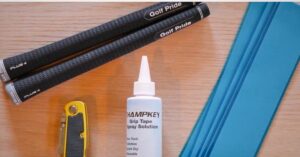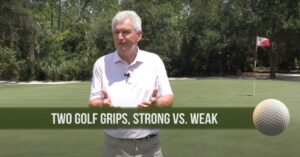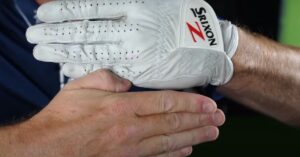How Long For Golf Grips To Dry? Performance And Longevity
A firm grip is vital for any golfer aiming to perfect their swing and enhance overall performance on the course. Golf grips, however, require periodic maintenance to ensure peak functionality and longevity. If you’re wondering, “How long does it take for golf grips to dry?”
The drying time for golf grips depends on a number of factors. In general, it takes between 2 and 24 hours for grips to dry completely. However, some grips may dry faster or slower than others.
In this blog post, we will explore the ideal drying period and provide essential tips to keep your grips in top-notch condition, ensuring you always have the upper hand during your golf sessions.
Factors Affecting Drying Time For Golf Grips

The drying time for golf grips can be influenced by various factors that affect the adhesive used to secure them to the club shaft. Understanding these factors can help golfers optimize grip installation and replacement processes for better performance and playability.
Adhesive Type And Quality
The choice of adhesive plays a crucial role in determining the drying time of golf grips. Some adhesives are designed for rapid bonding, while others may require more time to set properly. High-quality adhesives often offer faster drying times and better grip durability.
Temperature And Humidity
Environmental conditions significantly impact drying time. Warmer temperatures generally accelerate the adhesive’s curing process, while cooler temperatures can slow it down. Likewise, higher humidity levels might prolong drying, while low humidity can expedite it.
Grip Material
The material composition of the golf grip can affect drying time. Rubber grips, for instance, might require more time compared to synthetic grips due to differences in porosity and how they interact with the adhesive.
Thickness Of Grip Tape
Grip tape is often used to build up the grip’s size and add extra cushioning. The thickness of the grip tape can influence the drying time, with thicker layers taking longer to dry and set.
Technique Of Installation
The way the grip is installed can impact the drying time as well. Improper installation techniques may result in air bubbles or uneven bonding, which can prolong drying and affect grip performance.
Storage And Pre-Installation Preparation
If the grips were stored in extreme conditions or were not properly prepared before installation, it could affect the adhesive’s effectiveness and, subsequently, the drying time.
Manufacturer’s Recommendations
Always refer to the manufacturer’s guidelines for the specific golf grip and adhesive being used. Manufacturers often provide recommended drying times and other essential instructions for optimal performance.
Pressure Applied During Installation
The amount of pressure applied while installing the grip can influence how well the adhesive spreads and bonds. Applying consistent and adequate pressure aids in achieving an optimal bond and reducing drying time.
Curing Time
While the adhesive may feel dry to the touch after a certain duration, it might still need more time to fully cure. Waiting for the complete curing time ensures a strong and long-lasting grip attachment.
How To Know If Your Golf Grips Are Completely Dry

Ensuring dry golf grips is essential for proper hold and swing. Moisture can impact your performance and lead to slippery grips, affecting your game. Learn how to identify completely dry golf grips with these simple steps.
Step 1: Visual Inspection
Check the surface of your golf grips for any visible signs of moisture or dampness. Look for water droplets or a shiny appearance on the grips, as these indicate that they are not entirely dry. If you notice any wet spots or moisture buildup, it’s essential to dry them thoroughly before your next round.
Step 2: Touch Test
Use your fingers to feel the texture of the grips. Dry grips should feel smooth and slightly tacky to the touch, providing a comfortable and secure feel in your hands. If the grips feel sticky, damp, or excessively smooth, they may still have moisture present.
Step 3: Paper Towel Test
Take a clean, dry paper towel and press it against the surface of the grips firmly. If the paper towel absorbs any moisture or leaves wet marks on the grips, it indicates that they are not completely dry. Repeat this test on different areas of the grips to ensure you cover the entire surface.
Step 4: Listen For Squeaks
While holding your golf club, gently twist the grip back and forth. If you hear any squeaking sounds or feel the grip moving with little resistance, it might be due to moisture between your hands and the grips.
Dry grips will not produce these noises and will offer a more stable hold during your swing.
Step 5: Store Properly
To prevent moisture buildup on your golf grips, store your clubs in a cool, dry place. Avoid leaving them in a damp environment or under direct sunlight, as both can lead to moisture retention.
Wipe down the grips after playing in wet conditions and use grip covers during rain or high humidity.
Step 6: Replace Worn Grips
Over time, golf grips can wear out and lose their ability to repel moisture effectively. If you find it challenging to keep your grips dry despite proper storage and maintenance, it might be time to replace them. New grips will enhance your control and overall golfing experience.
Tips To Speed Up The Drying Process For Golf Grips
Drying golf grips quickly is essential to maintain a proper grip and prevent moisture-related damage. Whether you’ve washed your grips or played in wet conditions, here are some effective tips to expedite the drying process and get back on the course quickly.
Use Absorbent Towels
After cleaning your golf grips, pat them dry with absorbent towels to remove excess moisture. Avoid rubbing, as it may damage the grips. Press gently to soak up the water.
Utilize Compressed Air
A can of compressed air can be handy in blowing air into the grip’s vent holes, helping to expel trapped water. Rotate the grip as you do this for better coverage.
Apply Isopropyl Alcohol
Isopropyl alcohol aids in drying grips faster. Dampen a clean cloth with alcohol and wipe it over the grips’ surface. The alcohol accelerates evaporation.
Use A Blow Dryer
Set your blow dryer to a low heat setting and hold it a few inches away from the grips. Move the dryer back and forth to distribute the warm air evenly.
Opt For A Dehumidifier
Place your golf clubs with grips inside a small space with a dehumidifier. The dehumidifier will reduce the surrounding moisture, helping the grips dry faster.
Store In A Warm, Dry Area
Find a warm, dry spot with good ventilation to store your clubs after playing in wet conditions. Avoid leaving them in direct sunlight as it may cause damage.
Elevate The Grips
If possible, prop your golf clubs upside down with the grips elevated. This position encourages water to drain away from the grip, promoting faster drying.
Speed Up With A Fan
Position a fan in front of your golf grips to facilitate air circulation. The moving air will aid in evaporating the moisture from the grips.
Use A Hair Wrap Technique
Wrap the grip with a clean, dry hair towel, and twist the ends. This technique helps draw out moisture from the grip material.
Consider Grip Enhancers
Some grip-enhancing products contain materials that absorb moisture. Apply these products after cleaning your grips to speed up the drying process.
Common Mistakes To Avoid When Drying Golf Grips

Many golfers make avoidable mistakes during this process, leading to premature wear and reduced grip effectiveness. To ensure your golf grips last longer and provide optimal performance, avoiding the following common mistakes is crucial.
Leaving Grips Wet For Extended Periods
One of the most common mistakes is leaving golf grips wet for too long. Moisture can seep into the grip’s material, leading to mold growth and deterioration.
After playing in wet conditions or cleaning your grips, make sure to dry them promptly to prevent damage.
Using High Heat Sources
Exposing golf grips to high heat sources like direct sunlight, hairdryers, or radiators can be detrimental.
Excessive heat can cause grips to dry out too quickly and lose their original feel and tackiness. Opt for a more natural drying method at room temperature instead.
Using Chemicals Or Solvents
Avoid using harsh chemicals or solvents when drying golf grips, as they can degrade the grip material and cause cracking or peeling. Stick to mild soapy water for cleaning, and make sure to rinse and dry thoroughly afterward.
Hanging Grips Vertically
Hanging golf clubs with grips vertically can lead to uneven drying, as water may pool at the bottom of the grip. This can cause grip distortion and affect your swing. Lay the clubs down horizontally with grips facing up to ensure even drying.
Neglecting Regular Cleaning And Maintenance
Failing to clean your golf grips regularly can lead to a build-up of dirt, sweat, and oils, reducing their effectiveness. Set a cleaning schedule and wipe down your grips with a damp cloth after each round to keep them in good condition.
Not Inspecting Grips For Damage
Before drying your golf grips, take a moment to inspect them for any signs of wear or damage. Look for cracks, tears, or significant wear, as using damaged grips can affect your performance and potentially lead to injury.
Overlooking Grip Replacement
Even with proper care, golf grips wear out over time. Don’t overlook the need for grip replacement when necessary. A fresh set of grips can significantly improve your grip on the club and overall game performance.
Frequently Asked Questions
If you’re wondering how long it takes for golf grips to dry and how it affects performance and longevity, we’ve got you covered. Check out these quick and clear FAQs to get all the answers you need.
How Long Does It Take For Golf Grips To Dry Naturally?
Golf grips typically take 24 to 48 hours to dry naturally after applying grip solvent. Factors like humidity and temperature can influence drying time.
Can I Play With My Clubs Immediately After Regripping?
It’s best to wait until the grips are fully dry before playing, even if they feel secure. Premature use can affect the adhesive’s effectiveness.
Does Using A Grip Drying Agent Speed Up The Process?
Yes, grip drying agents can significantly reduce drying time, usually to just a few hours. They are handy for quick turnarounds.
Are There Different Grip Options For Various Weather Conditions?
Yes, certain grips are designed to perform better in wet or humid conditions, providing enhanced traction and control. Choose accordingly for optimal play.
Conclusion
Drying time for golf grips is essential for peak performance and longevity. Factors like adhesive type, temperature, humidity, and grip material affect the process.
Proper drying ensures a secure and comfortable hold, leading to improved control and playability on the course.
Avoiding common mistakes and following care guidelines maximizes grip lifespan, enhancing the golfing experience.






